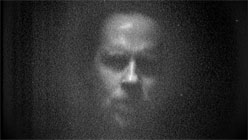The First Unitarian Universalist Church, built in 1889, will host an extraordinary evening with internationally renowned media artist Bill Viola on November 9, to celebrate the fiftieth anniversary of the San Francisco Zen Center. Viola, a former MacArthur “genius” fellow and representative of the United States in the 1995 Venice Biennale, will present a series of video projections set against the backdrop of the church’s gorgeous 1889 architecture and will speak in conversation with art historian John Walsh, former longtime director of the J. Paul Getty Museum. The notion of transformation runs through the artist’s work, the work of the Zen Center, and indeed the Unitarian Universalist Church, a faith that draws on many religious sources. The evening promises an undoubtedly intriguing confluence of elements. In an interview for this article, Viola remarked on the significance of the Zen Center and noted, “Most of the things that affect our lives — East or West — come from Mother Asia.”

Bill Viola, Three Women, 2008, Performers: Anika, Cornelia, Helena Ballent, Photo: Kira Perov; Courtesy Bill Viola Studios.
Over the last forty years, Bill Viola has created elaborately constructed new media works including sound installations, electronic music performances, works for television broadcast and, interestingly, a three-song video suite for the Nine Inch Nails World Tour in 2000. Arguably, he is most widely known for videos presented as architectural installations. Ocean Without A Shore (2007) was presented in an exquisite 15th century Venetian chapel during the 2007 Biennale. An offshoot of this work, Three Women (2008) will be presented on Friday. Viola calls it “one of the best pieces I’ve ever done.” His work repeatedly interrogates the role of death as part of the natural life cycle. As a result, the videos are often looping scenes of destruction and renewal — fire and water feature prominently, along with dramatic compositions of figures in motion. To create Fire Woman (2005) the artist captured the reflection of a central female figure in a 90-foot long pool of water built in an airplane hanger. Much of production time was spent waiting for the pool to be perfectly still — surely a meditative exercise in patience if ever there was one. Many things can be coerced, but the stillness of water is a force of nature beyond our control and this notion is at the core of Viola’s work.

Bill Viola, Fire Woman, 2005, Performer: Robin Bonaccorsi, Photo: Kira Perov; Courtesy Bill Viola Studios.
The highly emotive aspect of Viola’s work has often garnered rancorous reviews from art critics. When remembering a particularly disdainful response to an exhibition at London’s legendary Anthony d’Offay Gallery the artist notes, “the art world doesn’t want emotion to be shown. In the intellectual world, the mind and the heart have been split apart.” Citing Buddhism, Christian Mysticism, and Islamic Sufism as early influences, Viola tosses off the critical convention that life and work must be regarded separately by saying, “My work is more than a body of art that I do. It is deeply connected to my soul and my family and the events in the world.” He has spoken widely about his own near death experience as a young boy when he nearly drowned in a lake — an event that seems ever present in the work — and on contending with the deaths of his parents. “The basic, deepest gift my parents gave me, in terms of their departures, was that I took my home videos and brought them to the studio. [Doing this] changed my life: It broadened my horizons. The beauty and intensity of the fact that we are all here temporarily shakes not just our intellect but our emotions too.”


